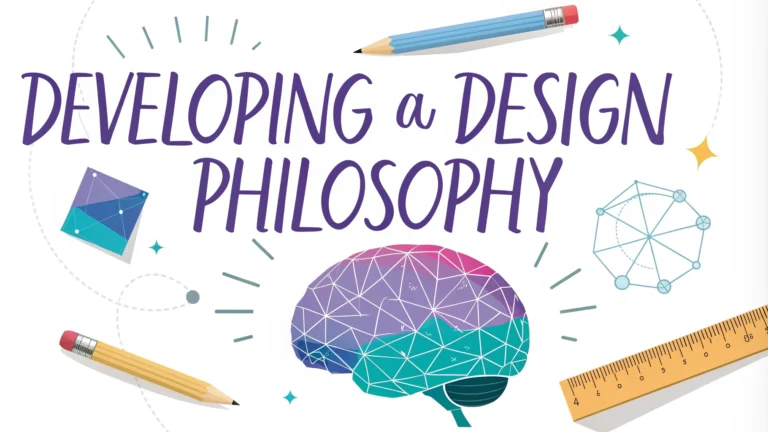A design philosophy shapes every decision you make during the logo creation process, transforming abstract ideas into meaningful visual solutions.
Your design philosophy acts as a compass, guiding choices about colors, shapes, typography, and overall aesthetic direction.
Core Elements of a Strong Design Philosophy
- Purpose-driven design choices
- Consistency across applications
- Timeless over trendy approaches
- Balance between simplicity and distinctiveness
Building Your Design Framework
Start by defining clear principles that align with both your creative vision and client objectives.
Key Questions to Ask:
- What emotions should the logo evoke?
- How will it perform across different mediums?
- What core message needs to be communicated?
- How can the design remain relevant over time?
Practical Implementation Steps
- Research Phase: Study the client’s industry, competitors, and target audience
- Concept Development: Sketch multiple variations based on your philosophy
- Refinement: Apply your principles to polish the chosen direction
- Validation: Test the design against your established guidelines
Common Philosophy Approaches
| Philosophy Type | Key Characteristics |
|---|---|
| Minimalist | Clean lines, essential elements only, strong focus on negative space |
| Symbolic | Heavy use of metaphor, deeper meaning, cultural references |
| Modern | Bold geometry, dynamic compositions, contemporary typography |
Technical Considerations
Your philosophy should address practical aspects like scalability, color usage, and reproduction methods.
Technical Guidelines:
- Design in vector format for infinite scalability
- Test logos in both color and monochrome
- Ensure readability at various sizes
- Consider both digital and print applications
Remember that a strong design philosophy evolves through experience while maintaining core principles.
Recommended Tools:
- Adobe Illustrator CC
- Sketch
- Figma
- Affinity Designer
Document your philosophy to maintain consistency across projects and team members.
A well-defined design philosophy sets you apart as a professional and ensures consistent, purposeful logo design outcomes.
Applying Your Philosophy in Practice
Translating philosophical principles into tangible design elements requires systematic approach and constant evaluation against established criteria.
Implementation Checklist:
- Create mood boards that reflect your philosophy
- Document design decisions and their rationale
- Establish clear feedback loops with stakeholders
- Maintain version control throughout iterations
Measuring Success
Evaluate the effectiveness of your design philosophy through specific metrics and feedback mechanisms.
| Success Indicator | Evaluation Method |
|---|---|
| Brand Recognition | Consumer surveys, recall tests |
| Versatility | Multi-platform implementation review |
| Longevity | Time-based performance analysis |
Future-Proofing Your Philosophy
- Regular industry trend analysis
- Continuous skill development
- Adaptation to new technologies
- Integration of emerging design tools
Building Client Trust
A well-articulated design philosophy helps establish credibility and facilitates better client relationships.
Essential Communication Points:
- Clear presentation of design rationale
- Regular progress updates
- Transparent revision processes
- Educational approach to design decisions
Conclusion
A robust design philosophy serves as the foundation for creating impactful, lasting logo designs. It combines creative vision with practical implementation, ensuring consistent quality across all projects. By maintaining and evolving your philosophy while staying true to core principles, you’ll create logos that not only meet current needs but stand the test of time.
Final Recommendations:
- Regularly review and update your philosophy
- Share knowledge with fellow designers
- Build a portfolio that reflects your principles
- Stay committed to continuous improvement
FAQs
- What is a design philosophy in logo creation?
A design philosophy in logo creation is a set of guiding principles and beliefs that inform the creative process, ensuring consistency, purpose, and meaning in every design decision made while creating logos. - How important is simplicity in logo design philosophy?
Simplicity is crucial in logo design as it ensures better recognition, versatility across different mediums, and memorable impact. Following the KISS (Keep It Simple, Stupid) principle helps create timeless logos that work at any size. - What role does color psychology play in logo design philosophy?
Color psychology is fundamental to logo design as it influences emotions and brand perception. Each color carries specific meanings and cultural associations that must align with the brand’s values and message. - How does scalability factor into logo design philosophy?
Scalability is essential as logos must maintain their integrity across various sizes and applications, from tiny favicon to large billboard. A well-designed logo should be recognizable whether it’s 16 pixels or 16 feet wide. - What is the importance of negative space in logo design?
Negative space creates balance, breathing room, and can add clever dual meanings to logos. It’s a powerful design element that can make logos more memorable and sophisticated when used intentionally. - How does typography influence logo design philosophy?
Typography communicates personality and brand voice through font choice and arrangement. The selected typeface must be legible, appropriate for the brand’s character, and work harmoniously with other design elements. - Why is versatility important in logo design?
Versatility ensures a logo functions effectively across all brand touchpoints, including digital and print media, different backgrounds, and various applications while maintaining its visual impact and recognition. - What role does market research play in developing a logo design philosophy?
Market research helps understand target audience preferences, competitor designs, and industry standards, enabling designers to create distinctive logos that resonate with the intended audience while standing out in the market. - How does cultural sensitivity affect logo design philosophy?
Cultural sensitivity ensures logos avoid offensive elements or misinterpretations across different cultures and markets. Designers must research cultural symbolism and meanings to create globally acceptable logos. - What is the significance of grid systems in logo design?
Grid systems provide structure and proportion to logo design, ensuring visual balance and harmony. They help create mathematically sound compositions that are aesthetically pleasing and professionally crafted.








